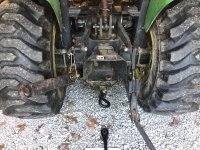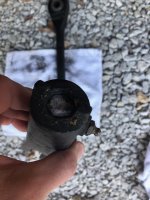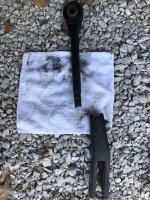OP
jorswift
Silver Member
- Joined
- Jan 2, 2018
- Messages
- 112
- Location
- Upland, IN
- Tractor
- JD955, MF1528, JD2240, JD 4300, Ford Jubilee
Yes - what most tractor 3-point specs explain quite poorly is - the listed weight that the 3-point is rated at, is at the lower link attachment point(bullseye). Some may even list the rated lift out 24 inches outboard of the bullseye. This is all well and good. But here comes the confusion - on any large 3-point implement (Ex - rear blade, rotary mower, LPGS etc) where is the "center of mass" for that implement. The center of mass is the point where we are concerned - what is your 3-point rated to lift at that point. Not at the bullseyes and not at the very rear of the implement.
3-Point Hitch
Type Category 1
Lift Capacity-61 cm (24 in.) Behind Link Arms (4200) 771 kg (1700 lb)
Lift Capacity-61 cm (24 in.) Behind Link Arms (4300 and 4400) 999 kg (2200 lb)
Center of mass for any implement can also be thought to be center of weight - my way of thinking, completely. I know from an engineering point it DOES get a lot more complicated - but not all of us would understand an engineering explanation. H e l l - I barely understand my own explanation here.
Perhaps an example would be easier to understand. My 2009 Kubota M6040 3-point system has the following rating - - at the bullseye, 4200 pounds 24" out from the bullseye, 3310 pounds
and at 48" out from the bullseye, 2500 pounds.
The heaviest implement I own is my Rhino 950 rear blade. Its 1055 pounds and sticks back of bullseye, on the 3-point hitch, 56". It also has the most rearward center of mass of all my 3-point implements.
My thinking says - center of mass is probably pretty close to center of weight of any implement. Not without a lot of screwing around, I found the center of weight for my rear blade. Its 38" back of the 3-point bullseyes. So I must figure if my 3-point is rated to lift my 1055 pound rear blade at a point 38" back of the bullseyes.
Now referring to the chart for the 3-point lift rating - - 38" back of the 3-point bullseye, my system has a lift rating of 2700 pounds. A little over twice the weight of the Rhino rear blade.
As you might have guessed - - there are those times when I have a lot of spare time on my hands.
There are two sets of data that you will probably have to determine for yourself. The center of mass for your implement and a 3-point lift rating graph/chart.
I obtained the 3-point lift rating data directly from Kubota corporate engineering.
I figure the center of mass is pretty close to the center of weight for any implement.
I am not smart enough to figure dynamic loading - movement of the center of mass when the implement is used - etc, etc.
Bottom line - it could well be that the center of mass for your implement is heavier than your 3-point is rated for - at that point.
Remember - your 3-point lift rating at the bullseyes is only good for a load that is centered directly above the bullseyes - not 24" or 36" or 48" back of the bullseyes.
3-Point Hitch
Type Category 1
Lift Capacity-61 cm (24 in.) Behind Link Arms (4200) 771 kg (1700 lb)
Lift Capacity-61 cm (24 in.) Behind Link Arms (4300 and 4400) 999 kg (2200 lb)



